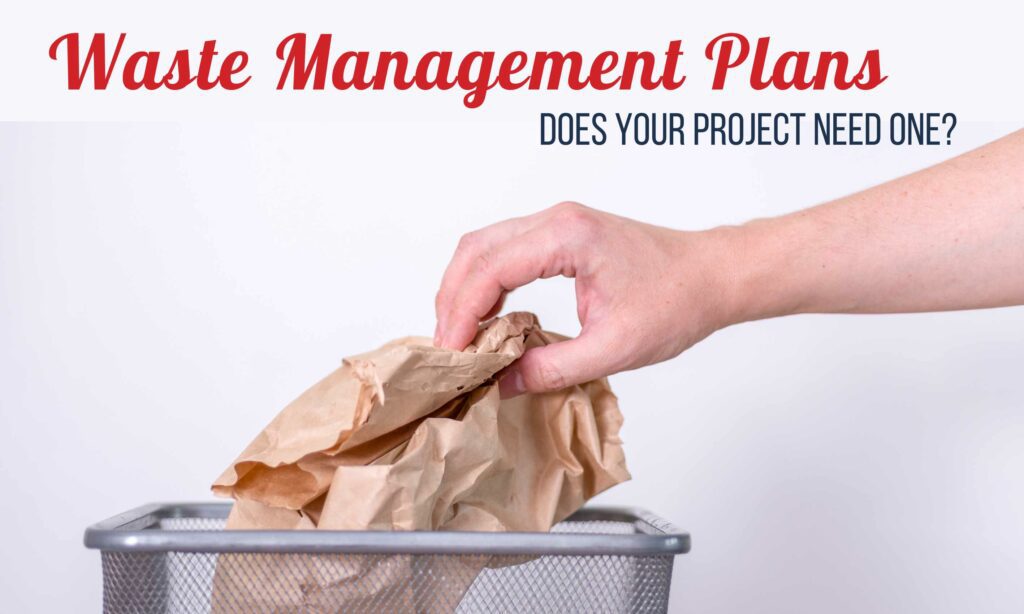17 Aug The Ultimate Guide to Waste Management Plans: Everything You Need to Know

Many planning applications will require a Waste Management Plan as part of the information request from the Council. Read on to discover what they are, what needs to be included and where you can go to get help if the Council request one.
What is a Waste Management Plan?
A Waste Management Plan is a report that details the likely waste generated for a particular use and how it will be managed once the use is established.
The purpose of a Waste Management Plan is to ensure that waste storage and collection is considered before a use is established, so that there is sufficient space to meet the future requirements.
Both residential and non-residential uses will often require a Waste Management Plan. Some projects such as apartments and new cafes or restaurants will always need a Waste Management Plan. These types of uses in particular have relatively high levels of waste generated and the Council needs to ensure the future facilities will be adequate for anticipated waste needs. However, many councils will ask for a Waste Management Plan either as part of an application or as a condition of the Planning Permit for other types of uses, even ones with relatively modest waste generation requirements, in order to ensure waste facilities are provided.
For some projects, Waste Management Plans can be a bit complex and require a professional assessment, but for a smaller project a simple plan may be all that is needed. Below I discuss the main parts of a Waste Management Plan to help you if you are wanting to try writing it yourself.
Components of a Typical Waste Management Plan
There are four main things that need to be included in a Waste Management Plan: assessment, storage, collection and management.
Waste Assessment: Identifying and categorising the types and quantities of waste generated.
This includes identifying the different types of waste (waste streams) that will likely be generated as well as the amount of each.
Waste Storage: Detailing how and where the waste will be stored on-site.
Once the types and quantities of waste that will be generated has been calculated, the storage requirements can be determined. This means working out the size and number of different bins required (for each waste stream) and where these bins will be stored. If waste areas are to be shared between different tenancies or units then this should be noted as well and access should be easy for all occupants.
Waste Collection: Detailing the type, frequency and process for waste collection.
The first thing to determine is if the waste collection will be by private contractor or Council service. The frequency of the waste collection may be partly determined by the amount of waste that will be generated and the amount of storage for bins that is available. In this section you should also detail how the collection process will be handled. Some questions to consider are: will the bins be moved by occupants to and from a collection area? If so, how will this process be managed, will it need to be a responsibility of a body corporate (if bins are shared)? Will vehicles enter the site to empty the bins? If vehicles will be entering the site then swept path diagrams will likely be required to demonstrate that there is enough space for these trucks to enter and exit safely.
Waste Management: Detailing any ongoing management processes.
Any processes that will require ongoing management to ensure there aren’t issues on or off the site should be noted in this section. Things such as regular bin cleaning or managing amenity issues such as noise from glass waste or odours would be discussed with actions to minimise any impacts detailed.
There are also some additional things that may be required for an individual Waste Management Plan:
Waste Minimisation Strategies: Implementing measures to reduce the amount of waste generated.
Treatment and Disposal Methods: Determining appropriate treatment or disposal methods for special types of waste. If a site could generate other waste types such as E-waste, hard waste or medical waste, these should be noted and the process detailed.
Education: Providing education or information to employees/residents.
For example, there may need to be information provided to all tenants on the process for waste storage and collection in an apartment complex or details of waste storage practices to minimise external impacts given to all staff of a commercial building. This may be in form form of signage or information.
How to Get Help With Preparing a Waste Management Plan
For simple projects it might be possible to prepare a plan yourself. There are a number of templates and guides available online. You can also access resources on Sustainability Victoria’s website, including a handy calculator to assist you in working out the estimated waste that your use will generate. Start here for information on both residential and commercial facilities
For more complex projects you will need the services of an expert consultant, typically a waste consultant or a traffic engineer. We have a range of consultants that we regularly work with and can recommend as part of our services of managing your planning application.

